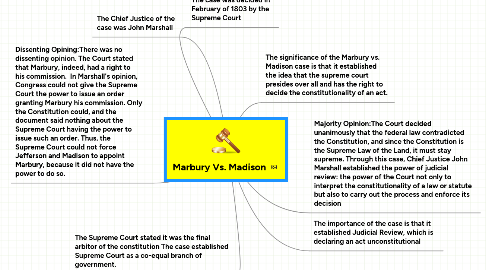Marbury Vs. Madison
von Kristen Boone

1. The case was decided in February of 1803 by the Supreme Court
2. The Chief Justice of the case was John Marshall
3. The Supreme Court stated it was the final arbitor of the constitution The case established Supreme Court as a co-equal branch of government.
4. Dissenting Opining:There was no dissenting opinion. The Court stated that Marbury, indeed, had a right to his commission. In Marshall's opinion, Congress could not give the Supreme Court the power to issue an order granting Marbury his commission. Only the Constitution could, and the document said nothing about the Supreme Court having the power to issue such an order. Thus, the Supreme Court could not force Jefferson and Madison to appoint Marbury, because it did not have the power to do so.
5. The importance of the case is that it established Judicial Review, which is declaring an act unconstitutional
6. Majority Opinion:The Court decided unanimously that the federal law contradicted the Constitution, and since the Constitution is the Supreme Law of the Land, it must stay supreme. Through this case, Chief Justice John Marshall established the power of judicial review: the power of the Court not only to interpret the constitutionality of a law or statute but also to carry out the process and enforce its decision
7. The significance of the Marbury vs. Madison case is that it established the idea that the supreme court presides over all and has the right to decide the constitutionality of an act.


